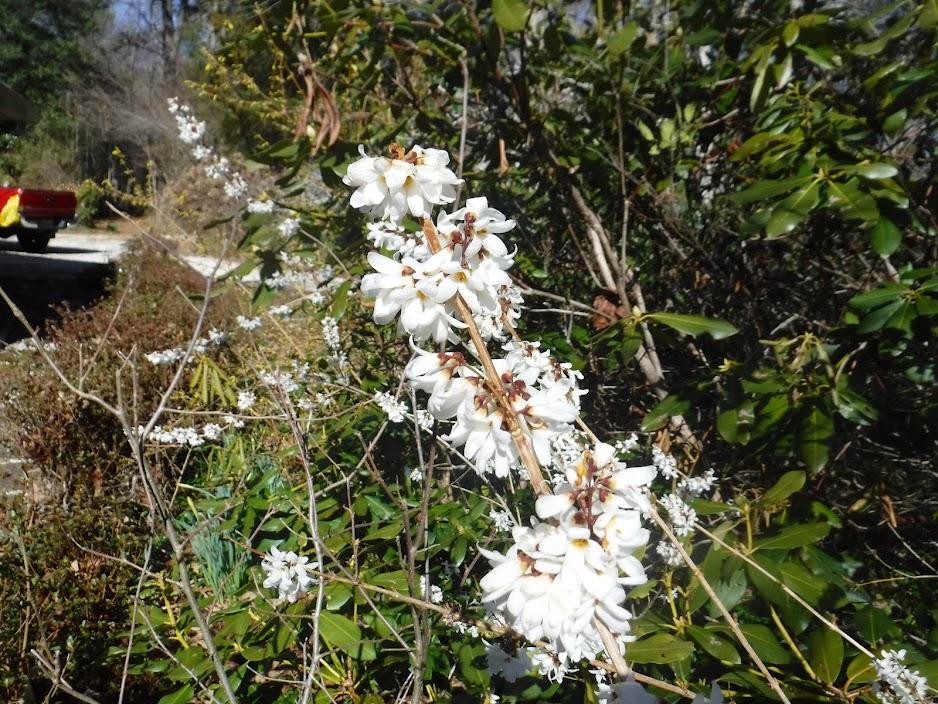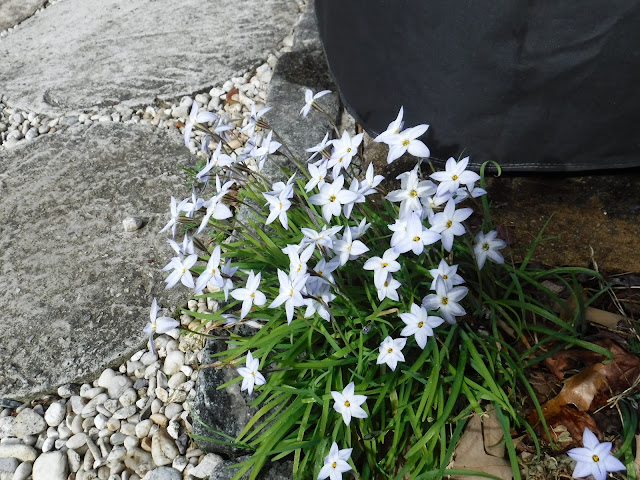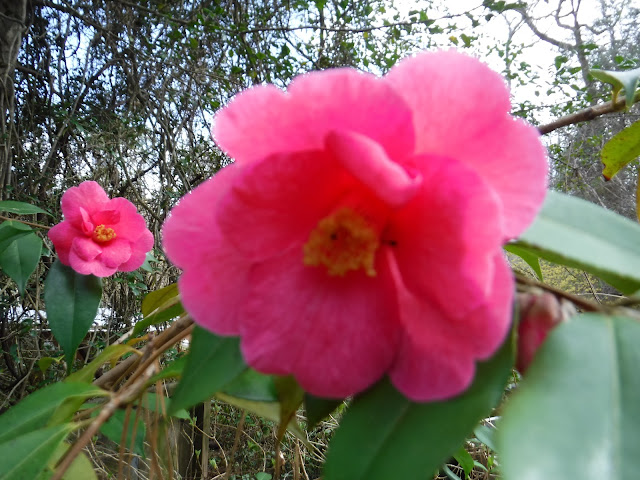Bogturtle's Garden- March 17 to 31, 2025
Frequently called the 'White Forsythia' this shrub is not one. And it seems to bloom while they are all still in bud, here. Abeliophylum distichum. Unlike Forsyrhia, also, it has a perfume. I am convinced that in an open, Sunny situation, it would be a dense fountain of bloom. I did take cuttings, yesterday, scraped the ends, dipped them in water and then in rooting compound. Now in a pot with a good many other cuttings. Hope springs eternal.
And that is pretty much in full bloom here.
A few 3/4 inch wide blooms on Ipheon, the Spring Starflower. Many plants line the walk in the back of the house, and unlike many another small Spring bulb, it puts out foliage that is green all Winter. I. uniflora, I think.
Hyla crucifer, the Spring Peeper, with a cross on the back that can be seen when the animal is lighter in shade, and they do change tone with stress, temperature and humidity. Finally removed the leaf catching net from atop the pool cover. Should have done that after Fall, but the ice was there so much. My grandson grabbed the little frog, for a photo. I only this morning put chlorine powder around the edges to repel them, as one year I did not and then had thousands of little black tadpoles to rescue and move to a local pond. And then I probably still did some frogicide, unfortunately. A lot goes on that you just
can't make up.
Again, probably one bulb. Planted before the rectangular bed was put here. And the bed was installed in a season where the bulb was totally dormant and not seen. I hope I remember to dig them up, later, for planting somewhere else. I moved dozens, last Fall, from where they were too tall for the little rock garden, and they are all up, in the circular bed I can see from where I dine. But, strangely, few flowers. Well, maybe next Spring.
A favorite, yet not in an ideal spot. Lots of shade and competition is limiting this extraordinary Rhododendron. R.mucronulatum 'Alba' is the rarer white flowered clone of this Korean native. The usual is purplish pink, and a special clone exists with bubble gum pink flowers. Purchased for its unusually early, sometimes Winter blooming flowers. But very frequently, they get blasted by the bitter weather. Not so far, this year.
The rather unimpressive twin blooms on the Wicopy, or Dirca palustris got this plant here because they, also, might be in bloom at the very end of Winter. And, as I said before, when I retired and was around every day, I wanted any of the Winter blooming plants that I came across. The Wicopy is interesting, if a person wants native craft material, as the bark strips off in long, unbelievably tough strips. I suppose our native tribes found that useful.
From another year, when snow came in March. I have heard of folks worrying about frost and Spring flowers. Most do just fine. But I don't think R. mucronulatum 'Alba' in the first photo, usually does.
The Starflower, Ipheon uniflora has bloomed more, and one single bloom of a slightly darker and smaller sort, called I.u.'Rolf Feidler. A nice color, even darker in real life. So I may order more, later this Summer.
Corydalis G.P. Baker has come back in the rock garden. One of the few that ever did, of the several I have planted, over the years. An easy plant from bulbs, and many a Corydalis does not form them. I cannot say if more flowers will come, and I believe it dies down later, in early Summer. Nor bigger and better, as compared to last year.
But my Lenten Roses, Hellebore hybrids, are thriving in the shade in the main perennial bed. They are increasing, and I am sure that is from the seeds I never harvest. White, and light and dark pink. Pretty expensive to buy the plants, usually, but a great range of colors is now available. Since they are so easy and successful, here, new ones would probably thrive, also.
A gardener even more fanatic than I am would probably get down and cut any Winter damaged leaves.
They are welcome to do that, at any time. I need a nap.
And here is another. Corylopsis spicata. I think this is the one originally released to the market from the amazing Winterthur estate just across the border from PA in Delaware. But the squirrels find the flowers appetizing, and so the blooms slowly disappear. Who would have thunk it.
Even more of the Spring Starflower have shown up. But no more of the deeper blue 'Rolf Feidler'.
And, as I might have mentioned, not one single 'Valerie Finnis' or any other Muscari, although they did fine, here, for many years. I did reorder some for this Fall planting.
The last day of March.
Taken out the bedroom window, and showing Magnolia soulangiana. Just beyond it, the fading blooms of R. mucronulatum 'Alba'.
Annoyingly, I cannot delete a photo accidently posted in duplicate. Just don't know enough, I guess.
On the walk to the barn/tool shed, this Camellia is in bloom. C. 'Red Candles' shows red in the bud all Winter.
Recall, as a child, being fascinated by yellow flowers in the dark woods we drove past. N. Jersey has lots of wood with few evergreens, so they are mostly brown, quite a while into Spring. The shrub was Lindera benzoin, the Allspice. How it was used and earned that name is something else I must learn.
Not too common locally, but this is certainly doing fine just behind the fence to the little rock garden.
A mystery. In all the years this plant has been here, it bloomed with a single flower years ago, And for what it is supposed to be, that blooming was at the appropriate time. Now it is in bloom before the leaves come, and it is supposed to be Magnolia virginiana, I think. The common little swamp tree called, locally, the Sweet Bay. And this form appealed to me as being very unique for double blooms. I would not have bought it if these flowers, in appearance and number are typical.




















.JPG)



























I had thought I wouldn't have any starflowers but one day saw a few buds and then a few days later an explosion. Or if you call 11 flowers an explosion.
ReplyDeleteWould have put a like emoji if I knew how. Spring is lifting most folks, as it comes on.
Delete